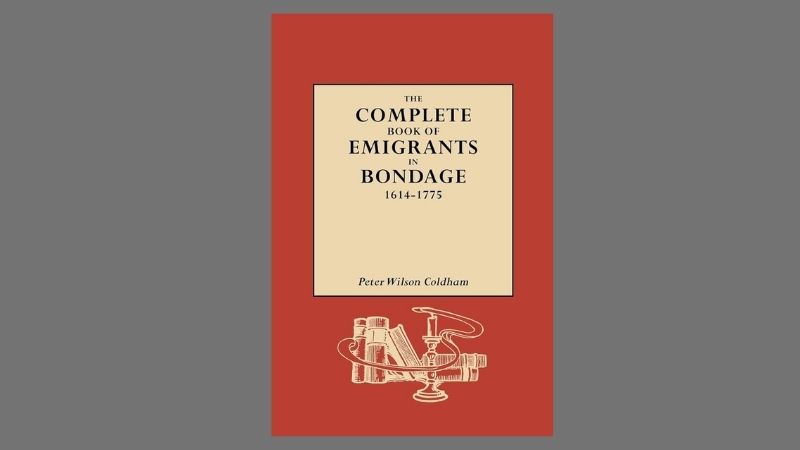The Complete Book of Emigrants 1614-1776: The emigration of individuals who came from England towards the American colonies from 1614 to 1776 was the genesis of the modern America. Peter Wilson Coldham’s The Complete Book of Emigrants 1614-1776 provides a significant genealogy record that documents around 140,000 people who emigrated from England to seek more opportunities, freedom or even as punishment. This comprehensive work can be an excellent resource for genealogists, historians and scholars who are seeking to comprehend how colonial movements are shaped and to trace families.
The Scope and Purpose of the Book
Coldham’s work collects emigration data drawn from a variety of sources, such as the court register, port registers as well as documents from the government. The records reveal the motives of migration, the circumstances that people travelled under, and the destinations they traveled to within America. American colonies. The complete book of Emigrants 1614-1776 is split into four volumes that cover different period of time:
- 1607-1660 the earliest settlers include one of the first permanently English colony in Jamestown as well as the first arrival of the Pilgrims in Plymouth.
- 1661-1699 A growing number of people as well as the indentured servitude system and the forced transport of convicts.
- 1750-1750: Large-scale migration due to the economic benefits as well as religious persecution and continuous transportation for the penal.
- 1751-1776 It was the period that preceded American Revolution and the final generation of British immigrants before the independence of Britain.
Who Were the Emigrants?
The people listed on the book The Complete Book of Emigrants 1614-1776 were from a variety of backgrounds. Many were self-employed settlers looking for religious freedom or financial opportunities, some were also transported on their own as convicts or servants. Some of the most important categories for emigrants comprise:
- Religious Dissidents Puritans, Quakers, as well as other religious groups who are facing the threat of persecution.
- Indentured servants: Poor individuals who were willing to serve for a certain period of time in exchange for a passage into the colonies.
- Convicts Convicted criminals are sent to transportation, rather than execution or jail.
- Political Exiles People who supported failed revolutions who were exiled.
- Merchants and Adventurers: Entrepreneurs seeking wealth through land speculation and trade.
Key Migration Routes and Destinations
The emigrants are portrayed on the Complete Book of Emigrants 1614-1776 predominantly went towards the American colonies. However, some traveled to the Caribbean as well as other British territories. Major destinations included:
- Virginia: The first ever permanent English colony in the United States, which attracted new colonists seeking land as well as tobacco cultivation possibilities.
- Massachusetts Bay Colony: It is a haven for Puritans as well as other groups of faith.
- Maryland: Established as a place of refuge for Catholics.
- Pennsylvania: Known for its tolerance of religion and an important Quaker community.
- The Carolinas and Georgia: Attracted planters traders, planters, and others who were involved in slavery.
The Transportation of Convicts
A major and intriguing features to The Complete Book Emigrants 1614-76 is the documentation of British policies of transferring convicts to colonies. The practice reached its peak at the end of the 18th century and thousands of criminals were transported into North America instead of serving prison time in the cramped British prisons. The convicts would often be sold into labor servitude indentured, either in plantations, or engaging in the city trades.
Indentured Servitude and Its Impact
The indentured service played an important function in the labor market of colonial times. Numerous people, especially those of England, Ireland, and Scotland were willing to serve for a specific period (usually between 4 and 7 years) as a payment for travel or food as well as shelter. When their contract was over and they had their freedom, they received it as well as sometimes land, even though their conditions differed widely.
The Importance for Genealogical Research
If you are looking for your ancestors, The Complete Book of Emigrants 1614-1776 offers valuable information. The book allows genealogists to:
- Find family names and migrate documents.
- Learn about the conditions under which your ancestors’ left for Europe.
- Link records to other historical documents, such as wills and grant of land, as well as parish archives.
- Track the movements of families throughout the Atlantic.
The Legacy of Colonial Emigration
The people mentioned as part of The Book Complete of Emigrants 1614-1776 had a major role in shaping the early American society. The migration of their descendants influenced the evolution of colonial societies, government institutions, as well as cultural customs. Knowing their travels can help researchers and historians of the present piece into the past, and get more understanding of the forces that formed their place in the New World.
Frequently Asked Questions (FAQ)
What is The Complete Book of Emigrants 1614-1776?
It’s a complete family tree written by Peter Wilson Coldham, documenting about 140,000 of the people who came out of England into the American colonies between 1614-1776.
Who is the creator, Peter Wilson Coldham?
Peter Wilson Coldham was a famous British historian and genealogist who was known for his research in depth on the colonial movement and records of transportation.
What details is the book able to provide?
The volume contains records drawn from numerous sources, including ports registers, court papers and archives from the federal government. The book lists the names, the reasons for migration and the destination of those who emigrated.
What is the structure of the book?
The book is split into four parts, each covers different periods of time:
- 1607-1660 The earliest settlers comprising the Jamestown colony as well as the Pilgrims.
- 1661-1699 Population growth Indentured servants, population growth, and convict transport.
- 1800-1750: Large-scale migration for religious and economic reasons.
- 1751-1776 the final wave of British migration to America before the American Revolution.
Who were the people who emigrated in this book?
The book outlines a broad variety of immigrants, such as:
- The Religious dissidents (Puritans, Quakers, and more)
- Indentured Service Servants (those employed as exchanges for the right to travel)
- Convicts (sent to colonies to be punished)
- Political Exiles (supporters of failed revolts)
- Merchants and Entrepreneurs (seeking commercial opportunities)
Which were the most popular places of departure for immigrants?
The majority of the emigrants were settled on the coasts of Virginia, Massachusetts Bay, Maryland, Pennsylvania, the Carolinas and Georgia. A few were shipped to the Caribbean and to other British territory.
What was the process of transferring convicts to colonies?
Britain shipped thousands of criminals to American colonies as a possible alternative to prison. Some were forced into an indentured servitude on the arrival.
The reason this book is useful in genealogical research?
The Comprehensive Book of Emigrants 1614-1776 offers essential details for finding ancestors’ names, understanding how migration patterns are shaped, and linking the family’s history with documents from the past.
How do I get the book?
The book can be purchased through the major genealogical search platforms as well as historical societies and libraries. The book can also be bought at online shops.
What’s the significance of this book?
It is a valuable reference for historians, genealogists or anyone else looking for information on colonial American historical events, offering details of the process of migration that was a major factor in the development of the early United States.
Conclusion
The Compleat Book of Emigrants 1614-1776 is an indispensable reference for all those who are who are interested in the history of colonial times as well as genealogy and research on migration. In assembling official records as well as personal stories, Peter Wilson Coldham created an irresistible record of the courageous, ambitious, and at times desperate, individuals who fled England in search of a better living in America. The tales of these individuals remain a source of inspiration and enrich our knowledge of the past. They also provide an unrivalled glimpse of the underlying principles of contemporary America.


